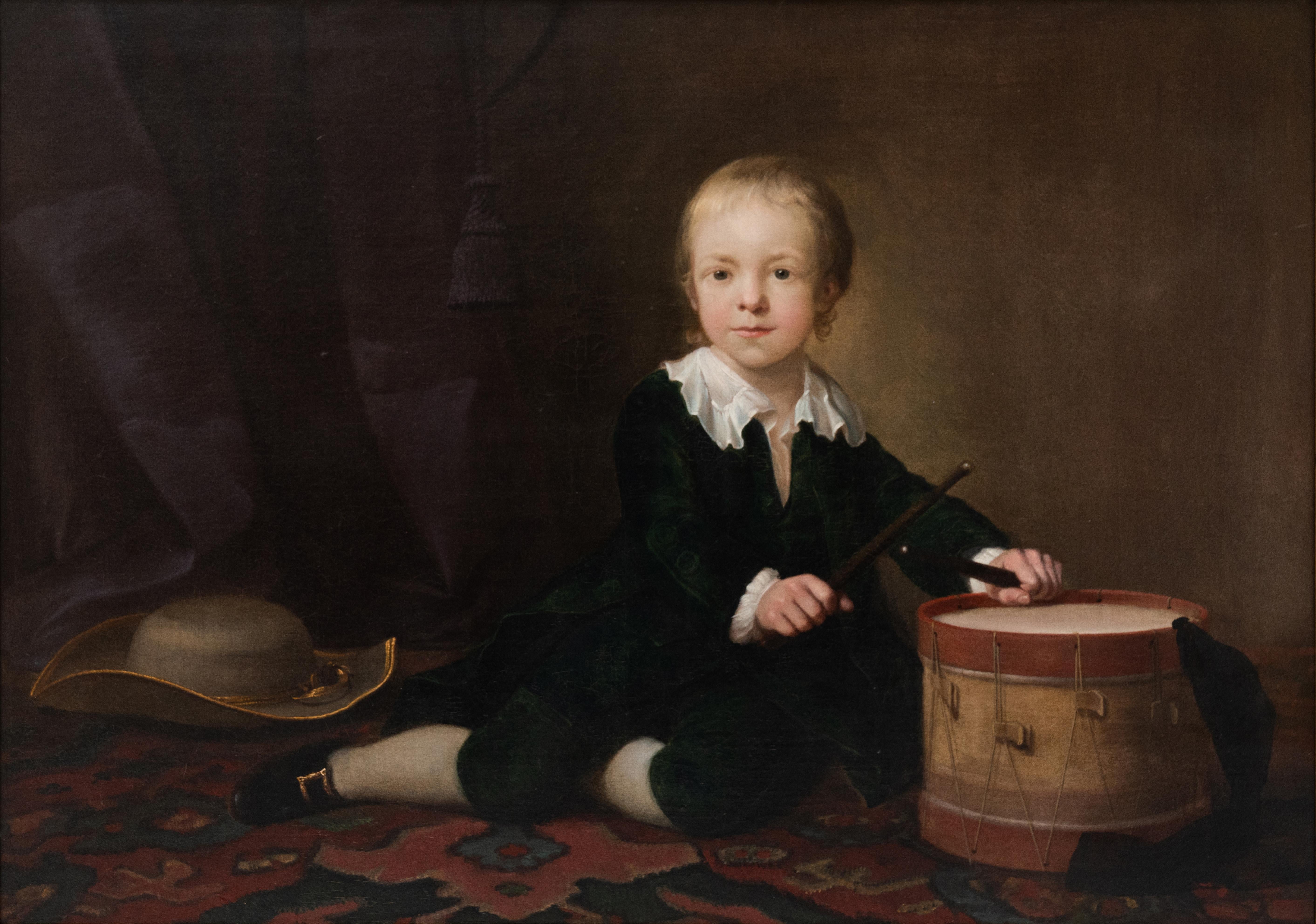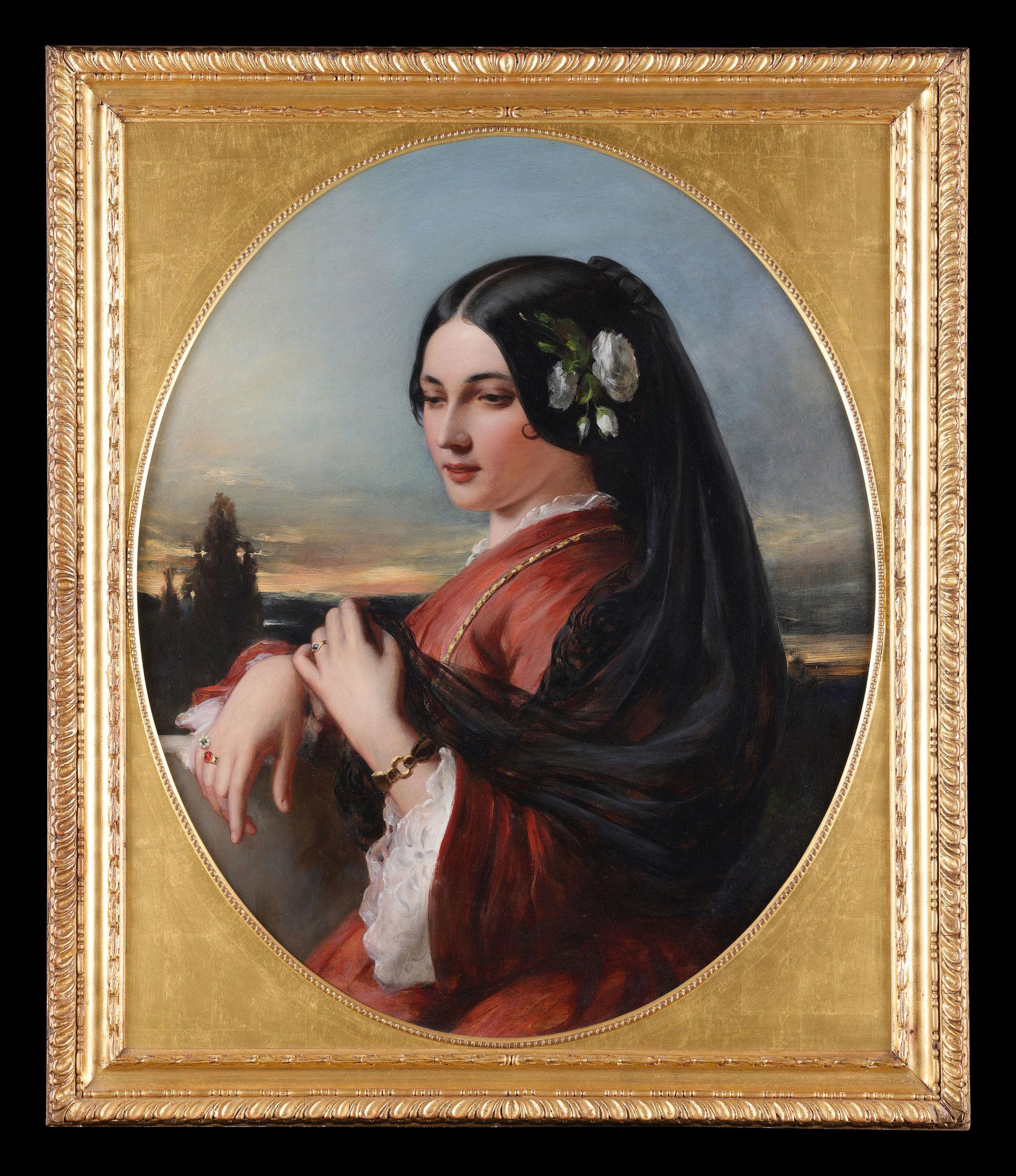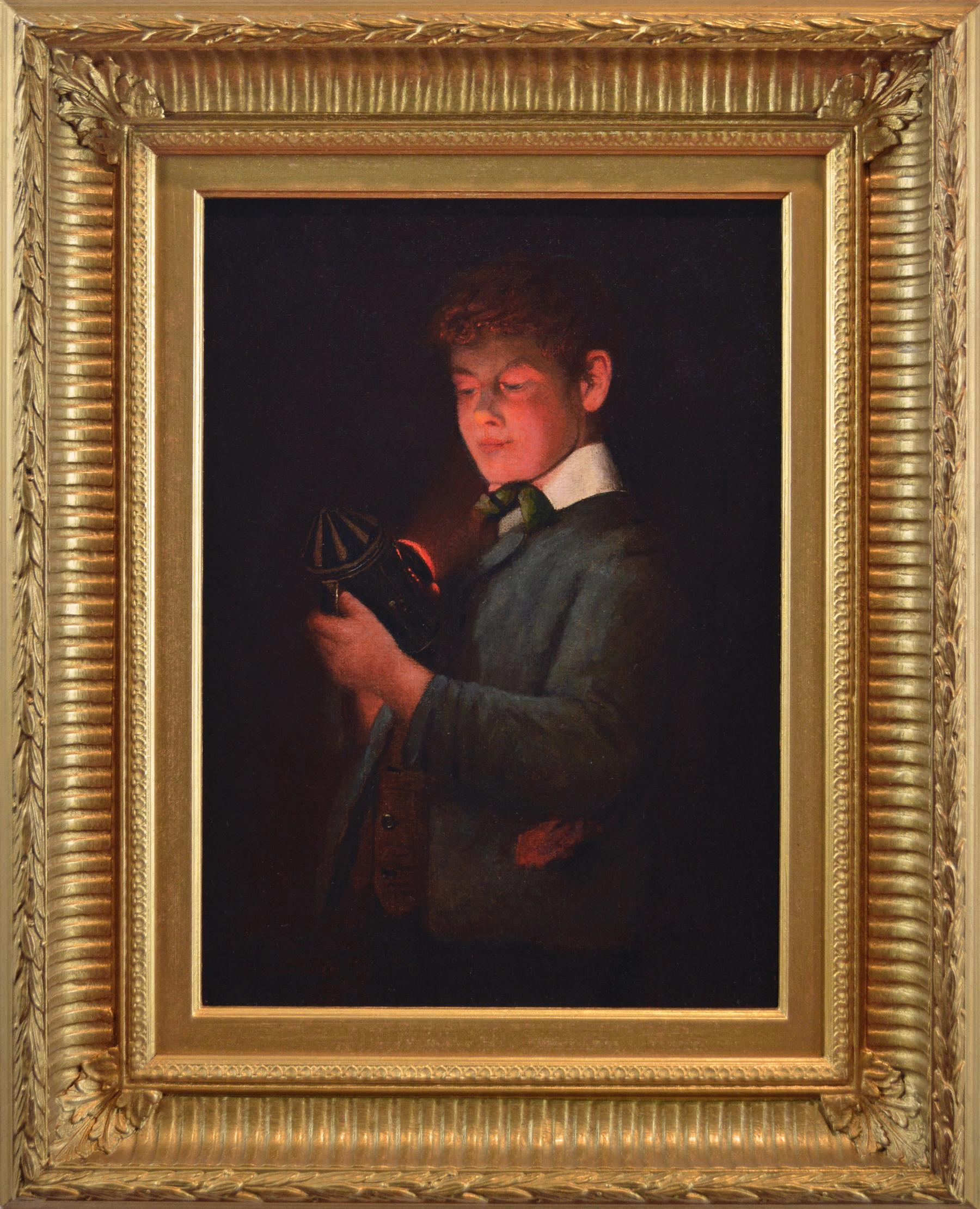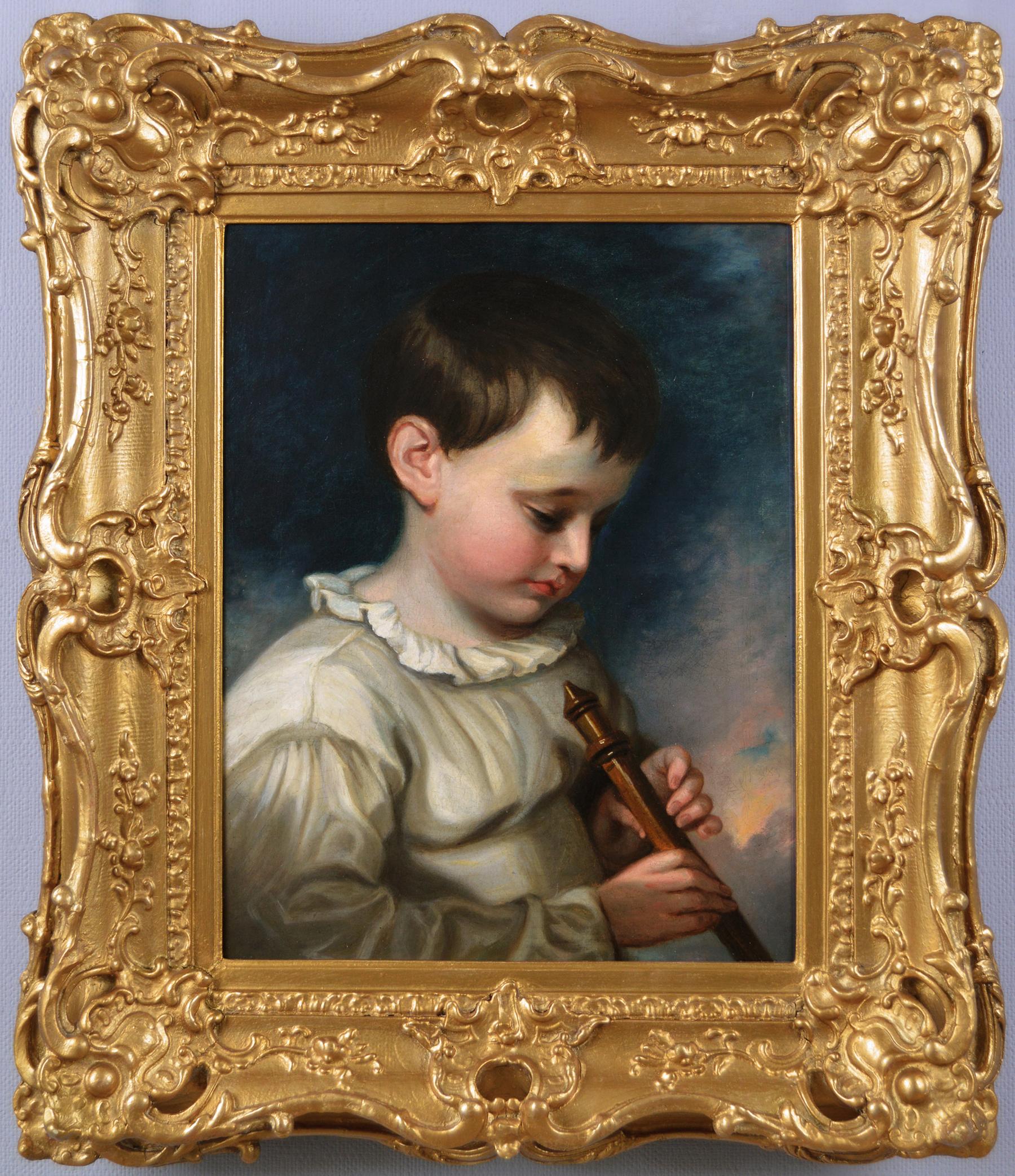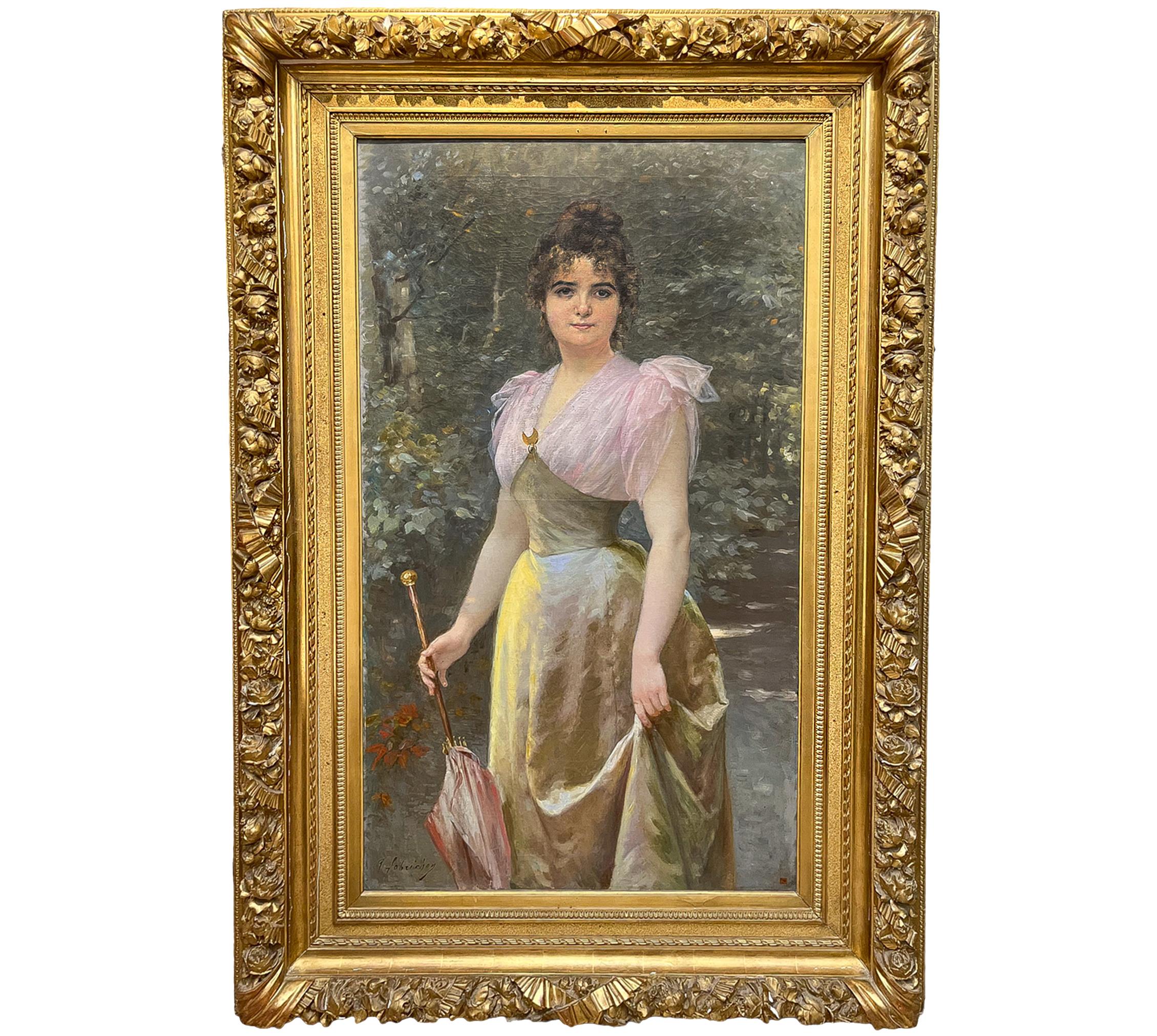Items Similar to The Gossip - Scottish 19thC art Victorian oil painting young romantic couple
Want more images or videos?
Request additional images or videos from the seller
1 of 14
William Fettes DouglasThe Gossip - Scottish 19thC art Victorian oil painting young romantic couple1868
1868
About the Item
A fine Victorian Scottish genre oil on canvas painting which dates to 1868 and is titled The Gossip by famous Scottish artist William Fettes Douglas RSA. It is a stunning depiction of a courting couple in very good condition. It is a very evocative genre painting and a fine period oil painting. Douglas is a highly sought-after genre artist whose paintings are listed in the auction catalogues to many thousands GBP.
Signed upper right.
Provenance. Scottish estate.
Condition. Oil on canvas, 18 inches by 15 inches unframed and in excellent condition.
Housed in a fine frame 26 by 23 inches framed and in good condition.
Sir William Fettes Douglas (1822–1891) was a Scottish painter and art connoisseur, rising to be President of the Royal Scottish Academy. He was the eldest son of James Douglas and Martha Brook, grandniece of Sir William Fettes, bart., the founder of Fettes College. He was born on 12 March 1822 in Edinburgh. On the completion of his education at the High School of Edinburgh, he entered the Commercial Bank of Scotland, in which his father was accountant. However, the elder Douglas was an amateur of some talent, and the son devoted the leisure of the ten years he was in the bank's service to painting and drawing. In 1847 he resolved to become an artist. Beyond a few months in the Trustees' Academy, then under Sir William Allan, he did not receive any systematic training, but he disciplined his hand and eye by the care and accuracy of the drawing he did by himself. He also attended the botany and anatomy classes of the university, while at a somewhat later date he painted a good deal in the country with the Faeds and Alexander Fraser, the landscape painter. In 1845, he exhibited for the first time at the Royal Scottish Academy, and soon his pictures attracted such notice that, in 1851, he was elected an associate, and three years later a full member. Some of his finest pictures belong to about this time, such as 'The Ruby Ring' (1853), 'The Alchemist' (1855), 'Hudibras and Ralph visiting the Astrologer' (1856), an incident from Butler's famous work 'The Rosicrucians' (1856), one of his finest things in colour and 'The False Astrologer'. The painter's interest in out-of-the-way subjects and his definite leaning to archaeology are clearly visible. Many of them show much of the pre-Raphaelite spirit, and are remarkable for wonderfully perfect and detailed handling and rich and beautiful colour. He also possessed a wide and accurate knowledge of pictorial art, which fitted him admirably for the curatorship of the National Gallery of Scotland, in which he succeeded James Drummond (1816-1877). He incorporated much of what he knew in the catalogue of the gallery. This office he held from 1877 to 1882, when he was elected to the presidential chair of the Royal Scottish Academy, vacant through the death of Sir Daniel Macnee. He was knighted at Windsor on 17 May 1822, and appointed a member of the Board of Manufactures, while in 1884 the university of Edinburgh conferred the degree of LL.D. upon him. After 1870 he turned more to landscape, and in 1874-5 he produced 'Stonehaven Harbour' and 'A Fishing Village,' which are perhaps the finest pictures that he painted. But for some time after 1879, the effects of a serious illness laid him aside, and when he resumed his art it was to practise in water-colour only. From 1877 to 1882 he served as Principal Curator of the National Gallery of Scotland, being succeeded by Gourlay Steel. His drawings are small in size but very charming, and show a true appreciation of the medium. In the National Gallery of Scotland, he is represented by three characteristic works ; South Kensington Museum has 'The Alchemist,' and Glasgow Corporation Galleries 'Bibliomania.' His works are displayed at such notable museums as the National Galleries of Scotland, Harvard University Art Museums, the National Portrait Gallery, Tate Gallery and the Victoria and Albert Museum. He died at Newburgh, Fife, on 20 July 1891, but is buried in the south-west spur of Dean Cemetery.
- Creator:William Fettes Douglas (1822 - 1891, Scottish)
- Creation Year:1868
- Dimensions:Height: 26 in (66.04 cm)Width: 23 in (58.42 cm)Depth: 2 in (5.08 cm)
- Medium:
- Movement & Style:
- Period:
- Condition:
- Gallery Location:London, GB
- Reference Number:1stDibs: LU853113420162
About the Seller
5.0
Platinum Seller
These expertly vetted sellers are 1stDibs' most experienced sellers and are rated highest by our customers.
1stDibs seller since 2018
398 sales on 1stDibs
Typical response time: <1 hour
- ShippingRetrieving quote...Ships From: London, United Kingdom
- Return PolicyA return for this item may be initiated within 14 days of delivery.
More From This SellerView All
- Harvest Time - British Victorian exhibited art figurative landscape oil paintingLocated in London, GBThis superb large exhibited British Victorian oil painting is by noted artist Thomas Falcon Marshall. Painted in 1849 it was exhibited at the Royal Academy London that year. This lar...Category
19th Century Victorian Portrait Paintings
MaterialsOil
- Portrait of Children at Play - British Victorian Genre art oil painting interiorBy Joseph ClarkLocated in London, GBThis lovely British Victorian genre oil painting is by noted artist Joseph Clark. Painted in 1881 it is a charming composition of three young children playing with a doll on the floor of a cottage by the hearth. Historically it has been entitled Children at Play but also known as Playing Doctors according to the literature. There is lovely colouring and detail. A very sweet British Victorian genre oil painting by a much collected artist. Signed and dated 1881 lower right. Provenance. Joseph Clark ; A Popular Victorian Artist and his Work by Eric Galvin. Plate 23. Children at Play (1881) Page 132f. Condition. Oil on canvas, 29 inches by 22 inches and in good condition. Frame. Housed in a gilt frame, 36 inches by 29 inches and in good condition. Joseph Clark (1834-1926) was born near Dorchester, Dorset. He studied painting in London under J. M. Leigh (1808-1860), who was himself the only pupil of William Etty, RA (1787-1849), the celebrated painter of classical and historical subjects. Clark specialised in depicting domestic genre subjects of a tender nature which generally featured children and he also painted a small number of biblical subjects. In 1857 at the age of twenty three he exhibited his first painting at the Royal Academy and he continued to exhibit there for all but two of the subsequent forty seven years. Many Victorian painters sought to demonstrate their social conscience through emphasising in their paintings the importance of family life and Joseph Clark was no exception. Whilst avoiding the overly sentimental style of some of his contemporaries, he frequently chose subjects which sought to remind people of their good fortune in having a caring family at a time when many children grew up as orphans in workhouses. Clark enjoyed considerable success with his paintings, maintaining both a London house and a home in the country for much of his life. In 1876 he was awarded a medal in Philadelphia for his paintings 'The Sick Child...Category
1880s Victorian Portrait Paintings
MaterialsOil
- Blessing the Harvest - Belgian 19thC art figurative Victorian oil paintingLocated in London, GBThis stunning arched top Victorian figurative oil painting is by noted Belgian artist Charles Soubre. It was painted in 1853 and is signed and date lower right. The composition is a ...Category
1850s Victorian Figurative Paintings
MaterialsOil
- Portrait of a Lady with Pendant - British Art Deco 30's portrait oil paintingLocated in London, GBThis gorgeous Art Deco portrait oil painting is by British female artist Elsie March. Elsie was one of 9 siblings, eight of whom became artists. Although Elsie later went on to focus...Category
1930s Realist Portrait Paintings
MaterialsOil
- Portrait of Lady Ruthven - Edwardian Society British American art oil paintingBy James Jebusa ShannonLocated in London, GBAn original oil on canvas by Sir James Jebusa Shannon. The painting depicts Lady Ruthven in a stunning silk and lace dress. It dates to the Edwardian period and depicts a bold Britis...Category
20th Century Realist Portrait Paintings
MaterialsOil
- At the Foot of the Statue - Scottish art Impressionist figurative oil paintingBy William Strang, R.A., R.E.Located in London, GBA fine large oil painting by Scottish listed artist William Strang. This is a super evocative oil on canvas which depicts a family at "The Foot of the Statue". It was exhibited in 1904 in Bradford exhibition of fine arts lent by L W Hodson of Wolverhampton who was a patron of his work. This is a fine example of an early 20th century Scottish oil with good subject. It is a good size and signed. This wouldn't be out of place in Kelvingrove Gallery in Glasgow. Signed lower left. Provenance. Bradford Art Gallery 1904. Sotheby 19th June 2002 Guide price £20000-30000GBP. Condition. Oil on canvas. Image size 30 inches by 25 inches and in excellent condition. Housed in a fine period frame, 39 by 34 inches framed and in good condition. William Strang (1859-1921) was born at Dumbarton, the son of Peter Strang, builder, and educated at the Dumbarton Academy. He worked for fifteen months in the counting-house of a firm of shipbuilders before going to London in 1875 when he was sixteen. There he studied art under Alphonse Legros at the Slade School for six years. Strang became assistant master in the etching class, and had great success as an etcher. He was one of the original members of the Royal Society of Painter-Etchers, and his work was a part of their first exhibition in 1881. Some of his early plates were published in The Portfolio and other art magazines. He worked in many manners, etching, dry point, mezzotint, sand-ground mezzotint, and burin engraving. Lithography and wood-cutting were also used by him to create pictures. He cut a large wood engraving of a man ploughing, later published by the Art for Schools Association. A privately produced catalogue of his engraved work contained more than three hundred items. Amongst his earlier works were Tinkers, St. Jerome, A Woman Washing Her Feet, An Old Book-stall with a Man Lighting His Pipe from a Flare, and The Head of a Peasant Woman on sand-ground mezzotint. Later plates such as Hunger, The Bachelor's End and The Salvation Army were also important. Some of his best etchings were done as series—one of the earliest, illustrating poet William Nicholson's Ballad of Aken Drum, is remarkable for clear, delicate workmanship in the shadow tones, showing great skill and power over his materials, and for strong drawing. Another praised series was The Pilgrim's Progress, revealing austere sympathy with John Bunyan's teaching. Samuel Taylor Coleridge's Ancient Mariner and Strang's own Allegory of Death and The Plowman's Wife, have served him with suitable imaginative subjects. Some of Rudyard Kipling's stories were also illustrated by him, and his likeness of Kipling was one of his most successful portrait plates. Other etched portraits included those of Ernest Sichel and of J.B. Clark, with whom Strang collaborated in illustrating Baron Munchausen...Category
Early 1900s Impressionist Figurative Paintings
MaterialsOil
You May Also Like
- 18th Century Portrait of Daniel Giles as a boy, playing with his drum.Located in Taunton, GBABOUT THE SUBJECT: In this 18th Century portrait Katherine Read has portrayed Daniel Giles as a child sitting on a rug playing with his drum and his hat beside him. The detail of the ornaments such as the patterned carpet, the folds of the curtain and the child's velvet clothing...Category
18th Century Victorian Portrait Paintings
MaterialsOil
- A Spanish LadyBy Charles BaxterLocated in St. Albans, GBA perfect example of Charles Baxter's work. A beautiful Spanish lady wearing typical Spanish attire. Despite being unsigned, the painting has full provenance having being fully catal...Category
Late 19th Century Victorian Figurative Paintings
MaterialsOil
- Late 19th Century genre portrait oil painting of a boy holding a lanternBy Charles SpencelayhLocated in Moreton-In-Marsh, GloucestershireCharles Spencelayh British, (1865-1958) The Lantern Oil on canvas, signed Image size: 13.5 inches x 9.75 inches Size including frame: 20.25 inches ...Category
Late 19th Century Victorian Figurative Paintings
MaterialsCanvas, Oil
- Early 19th Century genre oil painting of a boy playing a fluteLocated in Moreton-In-Marsh, GloucestershireAttributed to Thomas Barker of Bath British, (1769-1847) Boy with Flute Oil on canvas Image size: 17.5 inches x 13.5 inches Size including frame: 26.75...Category
Early 19th Century Victorian Portrait Paintings
MaterialsCanvas, Oil
- 19th Century genre oil painting of a gentleman asleep at a tableLocated in Moreton-In-Marsh, GloucestershireHermann Armin Kern Hungarian (1839-1912) Siesta Oil on panel, signed, with wax seal to reverse Image size: 18.25 inches x 12.25 inches Size including frame: 23.75 inches x 17.75 inc...Category
19th Century Victorian Figurative Paintings
MaterialsOil, Panel
- Portrait of An Early 1900's Lady by Timoleon Marie LobrichonBy Timoleon Marie LobrichonLocated in New York, NYA large and striking female portrait titled "Red Umbrella" by Timoleon Marie Lobrichon (French, 1831-1914) This darling young woman portrait wearing an early 1900's light pink and green satin dress. Her delicate and beautifully rendered hands reach into the light as her face and upper body are carefully shaded by the lush greenery around her. A half moon brooch...Category
Early 20th Century Victorian Portrait Paintings
MaterialsCanvas, Oil
Recently Viewed
View AllMore Ways To Browse
Chairs At Auction
Ugly Face
Ocean Art Seth
Elizabeth Cady Stanton
Giorgio Bari
John Pai
Port Of Marseille
Painting Of A Piano
Male Form Oil
Modernist Portrait Paintings
1920s Womens Fashion
Layout Drawing
20s Mens
Large Painting And Africa
Figurative Black Male
Male Body Painting
Oil Portrait Paintings Men
Dior Mens Vest
